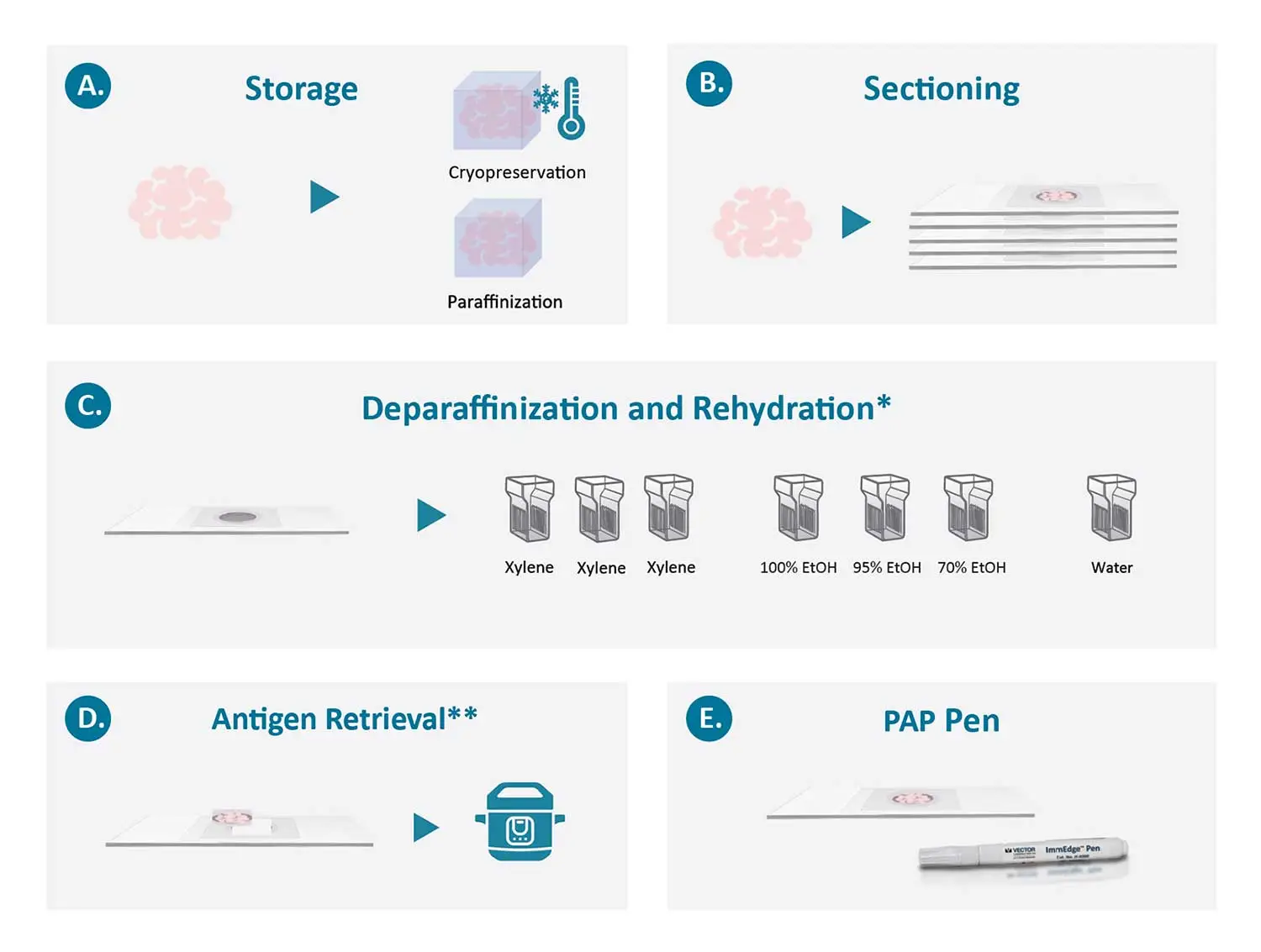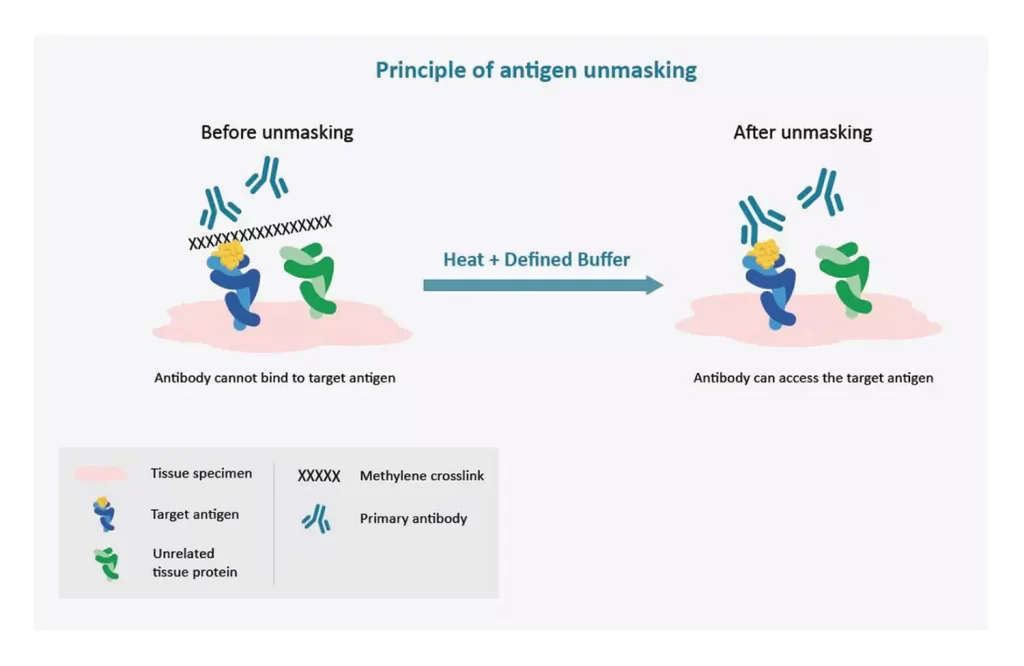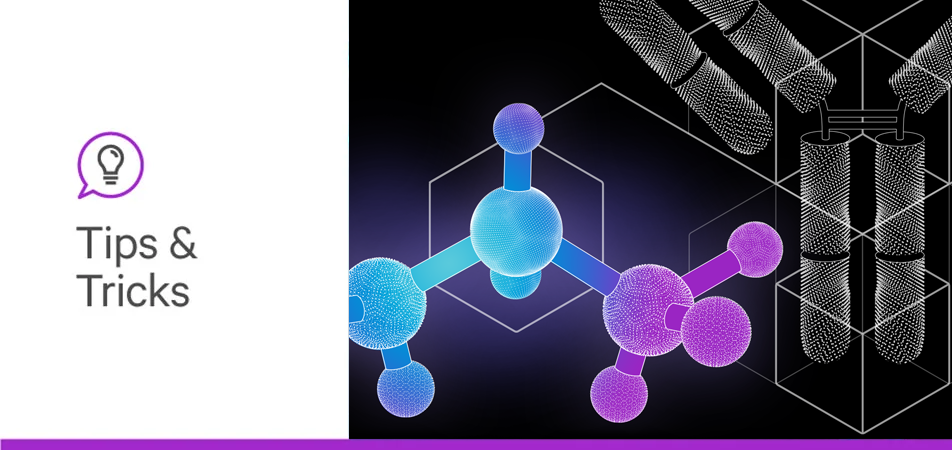


Popular wisdom says that finishing well is more important than how you start. But when it comes to immunohistochemistry (IHC) and immunofluorescence (IF), starting well is essential to great results. It’s crucial to thoroughly consider and plan the sample preparation process if you want clear and crisp immunostaining at the end.
Vector Laboratories created an in-depth Staining Sample Preparation Guide that provides an overview of the sample preparation process and offers guidance on making decisions and troubleshooting for each step. The different stages in the sample preparation process—storage, sectioning, deparaffinization and rehydration, antigen retrieval, and hydrophobic barrier application (Figure 1) — vary according to the tissue preservation method, which in turn depends on the final application. Thus, reading through the entire guide before starting your next IHC/IF experiment is a wise way to start strong and ensure excellent results.
Here’s a sneak peek of what you’ll find in the Staining Sample Preparation Guide.
After collecting the specimen, you have 2 choices for long-term tissue preservation—paraffin-embedding and cryopreservation. The formalin-fixation, paraffin-embedding (FFPE) process has several steps with specific purposes:
Cryopreservation is a simpler and quicker process than FFPE, and you can choose from 2 options when working with this approach:

What’s the right option for your experiments? It depends on the antigen in question, the final application, and some other factors. For example, FFPE is ideal for experiments that require very thin sections for higher microscopic resolution. Frozen blocks retain better antigenicity and are suitable for preserving highly sensitive proteins, post-translational modifications, enzymatic activity, and nucleic acids.
The Staining Sample Preparation Guide provides a detailed comparison of the pros and cons of the 3 available options for tissue preservation. It also highlights the steps that allow long-term storage and provides specific recommendations (temperature and length of storage) for ideal tissue preservation. The guide also includes a list of applications that can benefit from fixatives other than formalin (e.g., acetone, methanol, ethanol). One final bonus tip you will find under the sample storage section of the guide are 2 methods for quickly freezing specimens to avoid the formation of large ice crystals.
After choosing the best approach to preserve your specimen, you need to tackle tissue sectioning. The main decision required for this step is how thick you should cut your sections, and the 3 specific needs that can influence your choice are:
After getting your tissue slices on the slide, you typically need to allow them to air-dry for about 24 hours. However, the sample preparation guide provides some tips & tricks on how to shorten this step for a quicker drying process. It is critical to properly dry the sections to prevent detachment downstream in the workflow. If you constantly face this problem, you might benefit from using chemical adhesive reagents, such as VECTABOND® Reagent, Tissue Section Adhesion.
If you are working with FFPE sections, you need to remove the paraffin and rehydrate the tissue, or all the aqueous solutions downstream in the process won’t penetrate the specimen. This step is the exact opposite of the dehydration and paraffin impregnation process:
It’s crucial to use fresh reagents and allow adequate incubation time in each solution, or you might get uneven or patchy staining at the end. Also, note that thicker sections require longer incubation and wash times.
If you opt to use a formalin-based fixative, you likely need to include the antigen retrieval step in the IHC/IF workflow. During fixation, formalin promotes the formation of cross-links between amino acids of proteins in the specimen, which helps to harden the tissue and preserve overall morphology. But those cross-links also prevent the primary antibody from binding to the target epitope. You can use a proteolytic approach or heat-induced epitope retrieval (HIER) to break down the cross-links and unmask the antigen, but the latter yields better results (Figure 2).
The HIER process comprises 4 variables that you need to empirically determine—heat source, buffer pH, temperature, and incubation time. When performing antigen retrieval, start by checking the antibody manufacturer’s recommendation for the ideal retrieval buffer and temperature. Also, check the Staining Sample Preparation Guide as it discusses the many options available and how to make changes when necessary.
Congratulations! You’ve reached the end of the sample preparation process, and all that is left to do is to apply a hydrophobic barrier around the sections. Creating a barrier around the section allows for the use of different reagents on the same slide as well as a need for a smaller volume of solution to cover the sections, this in turn has the added benefits of flexibility and cost reduction for your experiments. In the past, nail polish was the go-to approach for completing this step, but using a ImmEdge® Hydrophobic Barrier PAP Pen is a much easier way of creating a hydrophobic barrier.
Remember, in the IHC/IF world, starting well is essential to great results. If you want to learn more about sample preparation and gather additional information to support your decision-making, download a copy of the Staining Sample Preparation Guide. If you need further support, reach out to our Technical Support team. We’re here to help you start and finish strong!






Stay in the Loop. Join Our Online Community
Products
Ordering
About Us
Application
Resources

©Vector Laboratories, Inc. 2025 All Rights Reserved.
To provide the best experiences, we use technologies like cookies to store and/or access device information. Consenting to these technologies will allow us to process data such as browsing behavior or unique IDs on this site. Not consenting or withdrawing consent, may adversely affect certain features and functions. Privacy Statement